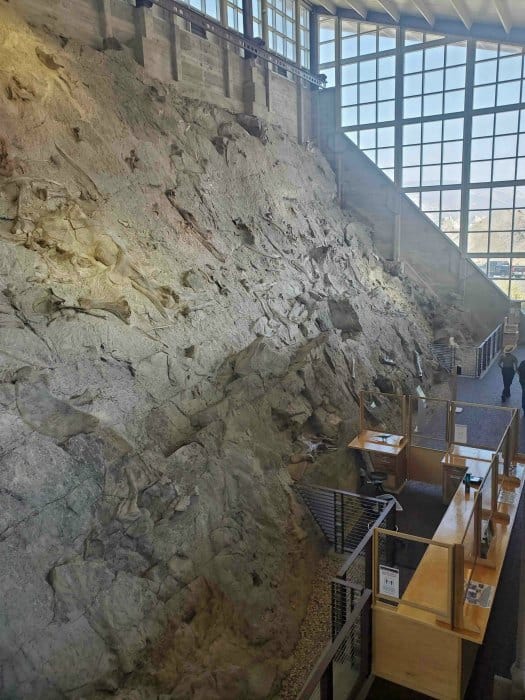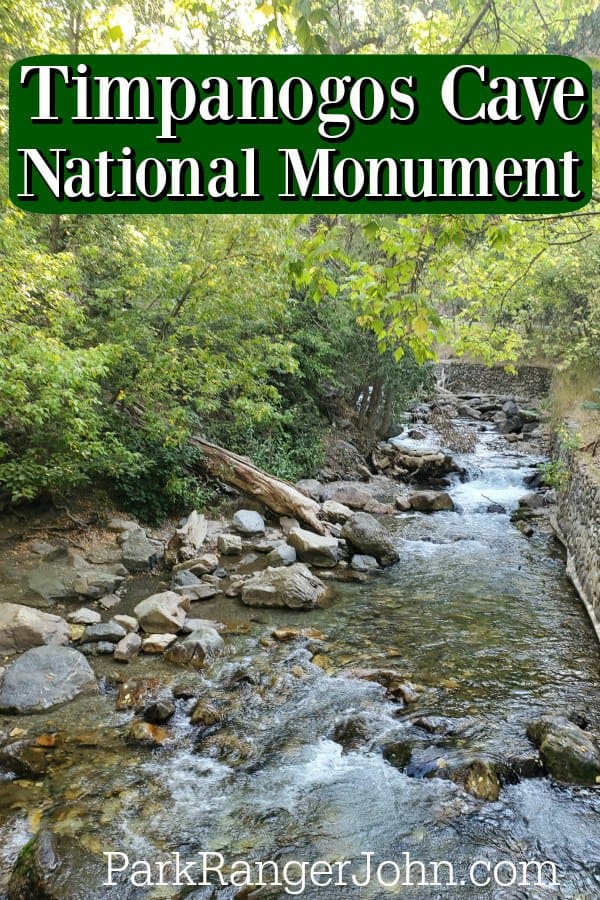National Parks in Utah include the amazing Arches National Park, Bryce Canyon, Canyonlands, Capitol Reef and so many more awe-inspiring destinations.
Utah National Parks are considered some of the best parks in our park system. They offer the opportunity to get off the grid and explore on foot, by boat, in a Jeep or on a horse.
There are so many things to see and do within the Utah National Parks. It is hard to pick just one to suggest starting with. I would love to spend a few months exploring all of these parks and finding new spots to explore.
With five outstanding national parks considered to be its "jewels," Utah is rich in history and scenery any visitor can appreciate.
These national parks-Arches, Bryce Canyon, Canyonlands, Capitol Reef, and Zion-each offer some of the most stunning Western landscapes and important geologic history within the National Park System of the United States. While some parks (like Zion) are more well known than others (Capitol Reef), each offers stunning vistas never to be forgotten.
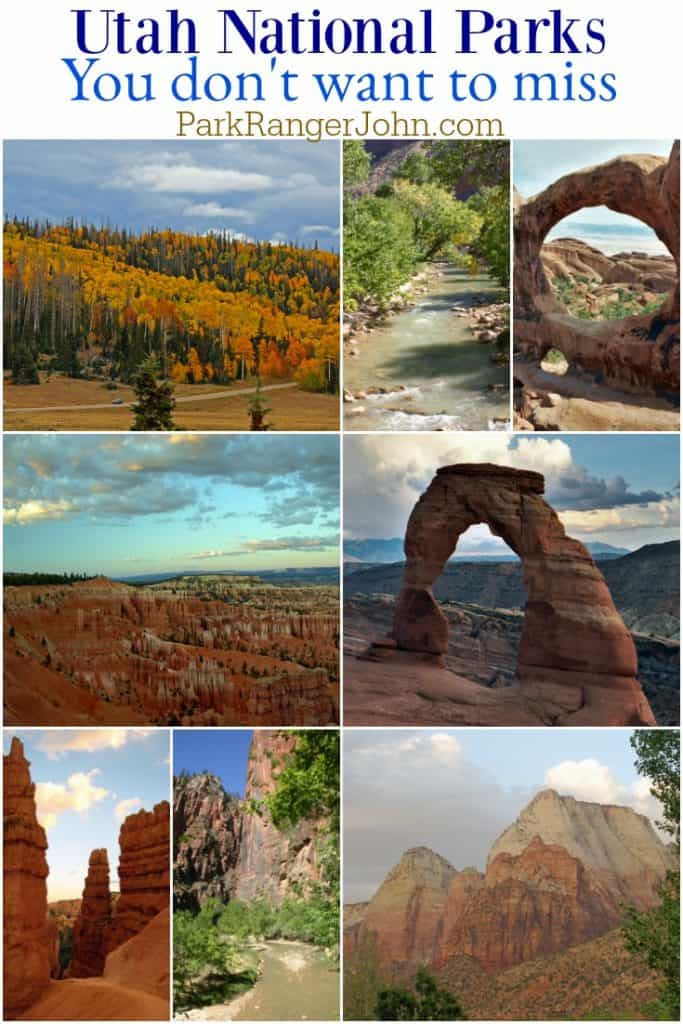
Utah National Parks
Southern Utah is where you will find Arches National Park, Canyonlands National Park, Bryce Canyon National Park, and Zion National Park. It can get very hot here so be sure to bring plenty of water if you plan to walk up to any of the natural wonders. Allow a minimum of one day for each National Park for the scenic drives. Allow more time if you plan to hike any of the trails.
Arches is probably the most often photographed red rocks. Moab is the closest town or campground to the Arches National Park at US 191 and I-70. There are seven arches carved out of the soft sandstone by wind and water visible from the road.
There are thousands of arches to see if you follow the hiking trails. Continue south from Moab at US 191 and Route 211 to the largest national park in Utah, Canyonlands National Park. You will see turrets and spires formed from sandstone.
Follow US 89 to Route 12, then Route 63 to Bryce Canyon National Park. Make reservations to stay in Bryce Canyon. Some call Bryce Canyon a fairyland because of the formations called hoodoos. Hoodoos look like hooded ghost shapes, especially in the moonlight.
The whimsical formations change color throughout the day from reddish-brown to light gold to flaming orange and deep red. St. George off I-15 in Southern Utah is the closest place to Zion National Park. Zion National Park is on Route 9 off of I-15.
Zion is named after the hill in Jerusalem where the Temple was built. Follow the Zion Canyon Scenic Drive to see a cluster of sky-high monoliths called the Court of the Patriarchs.
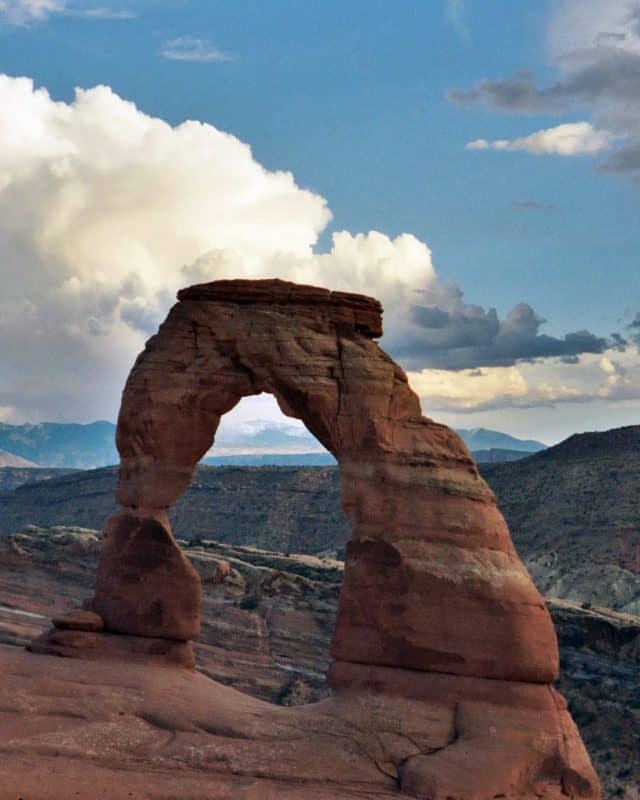
Arches National Park
Top Things to do - Auto Touring, Backpacking, Biking, Camping, Canyoneering, Commercial Tours, Hiking, Horseback Riding, Photography, Ranger-led Programs, Rock Climbing, Stargazing
Lodging - Arches National Park, located in Utah, does not have on-site lodging.
Camping - There are 51 sites at Devils Garden Campground located within the park
Park Address - Physical location of the park's entrance, it is located approximately 5 miles (8 kilometers) north of Moab, Utah, along U.S. Route 191
Arches NP is located in eastern Utah approximately 80 miles southwest of Grand Junction, Colorado. The park is open year-round offering scenic drives, hiking, and camping.
More than 2,000 sandstone arches dot the 47,000-acre landscape of this national park. Within this rugged, high desert setting, these delicate sandstone structures bear the imprint of geological history over millions of years.
The most famous landmark within the Arches National Park is Delicate Arch, which provides a sweeping vista of mesas, canyons, and the Colorado River from its lofty location.
Other notable stone monuments include Landscape Arch (the longest), Fiery Furnace, Courthouse Towers, Devil's Garden, Parade of Elephants, and Tower of Babel, among others.
A 40-mile scenic drive takes in the wonders of the park, and there are a number of stopping points, where visitors can get out and follow marked trails or enjoy scenic viewpoints.
Just some of the trails that travelers can pursue include Delicate Arch Trail, The Windows Trail, Double Arch Trail, and Tower Arch Trail. Throughout the park, visitors will enjoy the windowed arches, towering spires, and ancient hoodoos (tent rocks or spires) that make up the stunning vistas of this national park.
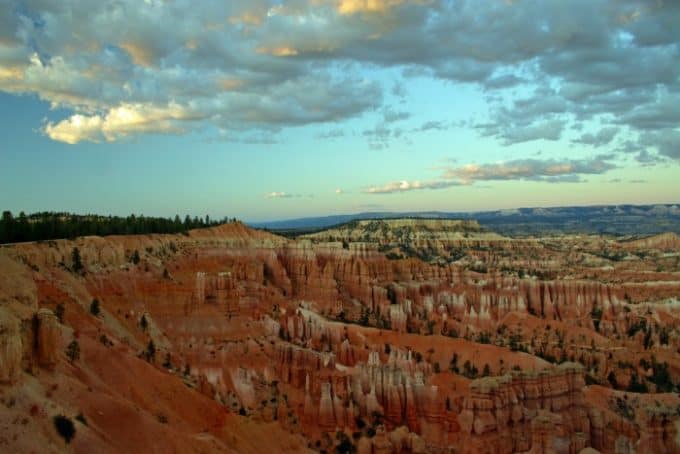
Bryce Canyon National Park
Top Things to do - See the Bryce Amphitheater, See the Bryce Amphitheater, See the Night Sky, Get Your Junior Ranger Badge, Day Hikes, Biking, Walk the Rim Trail, Explore the Visitor Center Museum, Wildlife Watching, Hike the Hoodoos, See the Park Film, Birdwatching
Lodging - The Bryce Canyon Lodge has 114 rooms, and there are a half dozen other hotels within a few miles of the park entrance.
Camping - Bryce Canyon National Park has two campgrounds, North and Sunset Campgrounds, located in close proximity to the Visitor Center, Bryce Canyon Lodge and the Bryce Amphitheater.
Park Address - Highway 63, Bryce Canyon National Park, Bryce, UT 84764
Bryce Canyon NP is located in Southern Utah approximately 120 miles northeast of St. George, Utah. The park is open year-round though winter snow can close some roads.
High atop the Paunsaugunt Plateau, lush greenery of pines gives way at the rim of Bryce Canyon, showcasing an 8,000-foot drop into an amphitheater of spectacular, brilliantly colored limestone rock formations. Surrounded by pink and orange cliffs, this canyon is filled with stunning red rock hoodoos, created by the interaction of wind and water over millions of years.
Summer sunsets are the most spectacular time to view the brilliant colors in this national park, although the park is open year-round.
Traveling along the 37-mile scenic drive will allow visitors to reach key scenic viewing areas to see rock formations such as Queen's Garden, Sinking Ship, Fairyland Canyon, and Inspiration Point. Participating in ranger-guided hikes and on horseback are two other great ways to see Bryce Canyon National Park in Utah.
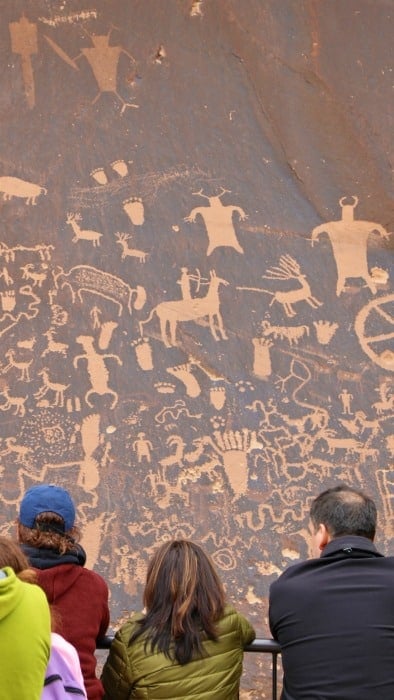
Canyonlands National Park
Top Things to do - Auto Touring, Backpacking, Biking, Boating, Camping, Camping, Guided Tours, Hiking, Horseback Riding, Ranger Led Programs, Stargazing, Junior Ranger Programs
Lodging - There are no lodging options within the park.
Camping - Canyonlands has two campgrounds, one at The Needles and one at Island in the Sky.
Park Address - Islands in the Sky Visitor Center - Grand View Point Rd, Moab, UT 84532
Canyonlands NP is located in Southeastern Utah approximately 110 miles southwest of Grand Junction, Colorado. The park is open year-round
In Canyonlands, Utah's largest national park, the sights are inspiring, whether you are looking thousands of feet down to the Colorado and Green Rivers or up thousands of feet to red rock pinnacles and spires.
The rivers have divided this national park into three distinct areas, each named to reflect its own special vista: Island in the Sky, the Needles, and the most remote district, the Maze. Renowned for its white water rafting, as well as 4-wheel drive and mountain biking trails, Canyonlands has much to offer the traveler to this Utah national park.
In addition, one of the things that makes this national park so unique is an area of petroglyphs left behind by the Fremont people (a Native American tribe).
Within the Needles District, travelers can see these ancient images of hunting scenes and harvesting left behind on the red rock face. This wild, rugged national park offers an amazing experience at any time of the year.
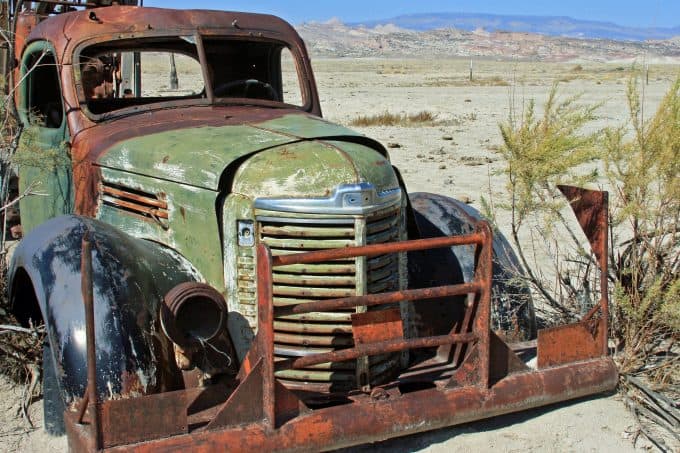
Capitol Reef National Park
Top Things to do - Scenic Drives, Hiking, Biking, Horseback Riding, Fruit Picking, Visit the Petroglyph Panel, Historic Schoolhouse, or the Gifford House Store and Museum, Guided Tours, Stargazing, Bcom a Junior Ranger, Camping
Lodging - There are no lodging options within the park.
Camping - With one developed campground, two primitive campgrounds, and vast backcountry options, there are many places to stay the night in the park.
The 71-site Fruita Campground is the only developed campground in Capitol Reef.
Park Address - 52 West Headquarters Drive, Torrey, UT 84775
Capitol Reef NP is located in south-central Utah approximately 200 miles south of Salt Lake City. The park is open year-round offering hiking, camping, and scenic drives.
The central geological feature of this national park is the Waterpocket Fold, a 100-mile long warp of rock rising up from the earth. Formed 70 million years ago, a fault below the earth's crust pushed up the layers of rock to create a monocline, better known today as the Capitol Reef.
Much of the rest of the park is a fascinating wilderness of sandstone formations, just some of which are Hickman Bridge, the Temple of the Sun and Moon, Cathedral Valley, and Capitol Dome. These highlights and others can be seen along a 25-mile scenic drive.
Also within the park are remnants of a 1800s pioneer town, Fruita, so named for its abundant orchards of apricots, apples, cherries, pears, and peaches. In addition to fruit-picking, a nature center, children's activities, afternoon ranger talks, and bird watching are popular pastimes within this Utah national park.
Abundant hiking opportunities exist, from easy family walks, like Sunset Point Trail, to the challenging, such as Navajo Knobs, a strenuous trail that rewards hikers with stunning panoramic vistas at its completion.
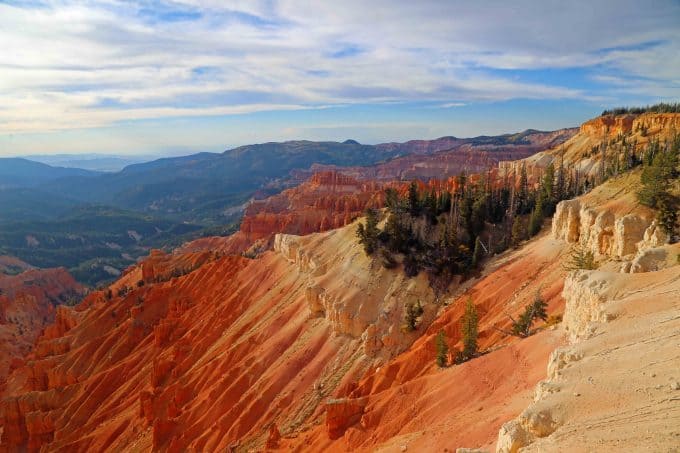
Cedar Breaks National Monument
Top Things to do - Ranger Led Programs, Camping, Hiking, Enjoy the Scenic Overlooks, Stargazing, Picnicking
Lodging - There are no lodging within the park.
Camping - The Point Supreme Campground has 25 campsites and accommodates both tents and RVs. Camping is available from mid-June to mid-September.
Park Address - 4730 South Highway 148, Brian Head 84719
Cedar Breaks NM is located in southwestern Utah approximately 65 miles northeast of St. George, Utah. The park is from late spring through fall. The park offers great scenic drives and hiking.
The park sits much higher than other parks on the Colorado Plateau. The visitor center is located at 10,000 feet in elevation. The park is blanketed in snow throughout the winter.
Dinosaur National Monument
Top Things to do - Camping, Hiking, Picnicking, River Rafting, Fishing, Stargazing, Wildlife Viewing, Scenic Drives, Guided Tours, Visit the Visitor Center
Lodging - There are no lodging or hotels within Dinosaur National Monument. However, the nearby communities of Vernal, Utah, Dinosaur, Colorado, Craig, Colorado, and Rangely, Colorado, have lodging.
Camping - With six different campgrounds located around the monument and over 120 sites to choose from, options are plentiful.
Park Address - Quarry Visitor Center, 11625 E 1500 S, Jensen, UT 84035
Dinosaur NM is located in northwestern Colorado and northeastern Utah approximately 110 miles south of Grand Junction, Colorado. The park offers dinosaur fossils and rock art, scenic drives, hiking, and camping.
Paleontologist Earl Douglas found eight vertebrae of a dinosaur in the arid badlands of eastern Utah. He had stumbled upon the world's greatest collection of dinosaur fossils.
Remains of ten species of dinosaurs have been found in this area. The fossils that have been excavated can be found in the Carnegie Museum, Smithsonian Institute and the Denver Museum of Natural History.
Glen Canyon National Recreation Area
Top Things to do - Kayaking, Biking, Camping, Hiking, Guided Tours, Scenic Drives, Ranger Programs, Fishing, Off-Road Vehicle Driving
Lodging There are several lodging options within the park, such as:
- Hotel rooms near the lake available at Lake Powell Resort in Wahweap
- Defiance House Lodge in Bullfrog
- Standalone Family Units (three-bedroom single-wide trailers) are available at Halls Crossing and Bullfrog
Camping - Pitch a tent on the beach or pull into a full hook up RV spot. You have camping options at Glen Canyon.
Houseboat Rentals- The original glamping, just on Lake Powell! There are two park consessioners who rent houseboats on Lake Powell.
Park Address - Carl Hayden Visitor Center, Hwy 89 at Glen Canyon Dam, Page, AZ 86040
Glen Canyon NRA is located in southern Utah and northern Arizona approximately 125 miles north of Flagstaff, Arizona. The park is open year-round and offers hiking, boating, camping, fishing, and exploring.
Lake Powell is the second-largest reservoir in the United States. The lake was formed after the construction of the Glen Canyon Dam on the Colorado River in 1963.
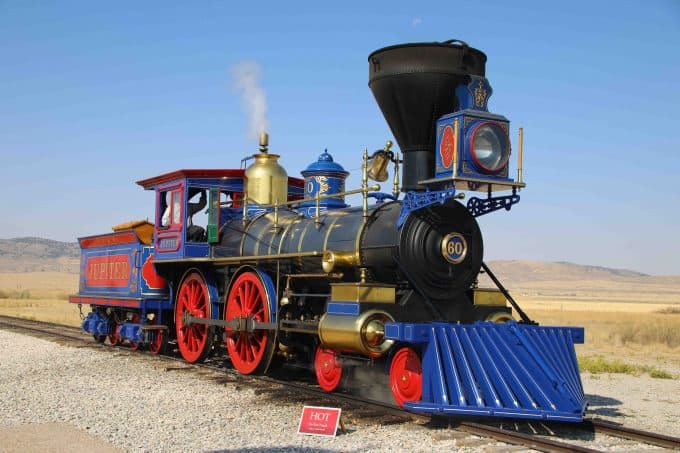
Golden Spike National Historical Park
Top Things to do - Watch trains Jupiter and No 119, Auto Tours, Locomotive Ranger Programs, Explore the Engine House, Hike the Big Fill Loop Trail
Lodging - There are no National Park Lodges within the park. The closest lodging can be found in Tremonton, Bringham City, and then in Ogden and Logan.
Camping - There are no campgrounds within the park.
Park Address - 6200 North 22300 West Promontory, Utah, UT 84307
Golden Spike NHP is located in northern Utah approximately 85 miles northwest of Salt Lake City. The park is open year-round and offers the opportunity to view steam locomotives and learn more about railroad history.
In Promontory Summit, Utah on May 10, 1869 officers from Union Pacific and Central Pacific Railroad met to celebrate where the railroad meets from coast to coast.
A golden spike completed the first transcontinental railroad line in the United States.
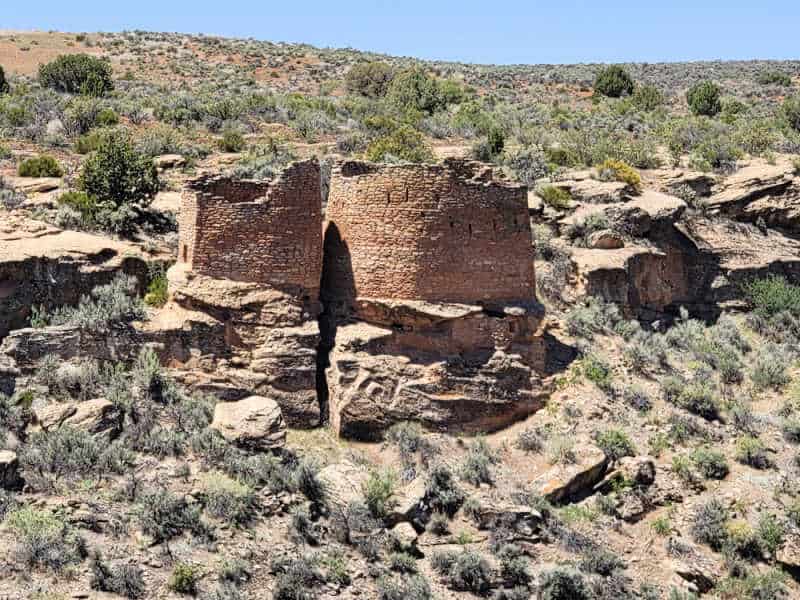
Hovenweep National Monument
Top Things to do - Hiking, Stargazing, Birdwatching, Picnicking, Visiting Cutthroat Castle, Square Tower Group, Horseshoe and Hackberry Groups, Holly Group, Cajon Group, Enjoy Arts in the Park,
Lodging - There are no lodging options within the park. The nearest hotels are in Monticello, Blanding, and Bluff, Utah, and Cortez, Colorado. These towns are about 40-45 miles (one hour's drive) from Hovenweep.
Camping - Hovenweep National Monument has one campground, located ¼ mile from the visitor center.
Park Address - Hovenweep National Monument Visitor Center, Montezuma Creek, UT 84534
Hovenweep NM is located in southwestern Colorado and southeastern Utah approximately 150 miles south of Grand Junction, Colorado. The park is open from spring through fall.
The park offers the opportunity to tour thousand-year-old pueblo ruins and camping. There are six pueblo communities protected within the park boundaries.
The park includes dwellings, kivas, and multi-story ruins. The visitor center and Square Tower Group of structures are the only unit within Hovenweep that can be reached on a paved road.
Natural Bridges National Monument
Top Things to do - Auto Touring, Hiking, Birdwatching, Stargazing, Ranger-led Programs, Arts in the Park, Picnicking
Lodging - There are no National Park Lodges within the National Monument.
The closest lodging is in Blanding, Utah
Camping - Natural Bridges has one campground located near the visitor center with 13 sites that are first come first serve.
Park Address - The entrance to Natural Bridges is at the end of UT 275, which is roughly 35 miles west of Blanding, Utah, on UT 95.
Natural Bridges NM is located in Southeastern Utah approximately 43 miles east of Blanding. The park is open year-round and offers camping, hiking, and a scenic drive.
Located east of Lake Powell this park showcases three rock bridges that have been carved in the sandstone of the Colorado Plateau by erosion.
Visitors can enjoy a 9-mile scenic drive that takes you to overlooks with epic views of the park's three natural bridges - Sipapu, Kachina, and Owachomo.
If you want to get a close-up look there are trails that lead to the bridges.
Rainbow Bridge National Monument (by boat only)
Top Things to do - Boat Tours from Wahweap Marina, Hiking
Lodging - There are no lodges within the Monument.
Camping - Camping within Rainbow Bridge National Monument boundaries is not allowed. Shoreline camping within Glen Canyon National Recreation Area is allowed.
Rainbow Bridge NM is located in Southern Utah approximately 125 miles north of Flagstaff, Arizona. The park is open year-round.
Rainbow Bridge is the world's largest known natural rock bridge. The bridge spans 290 feet from the base to the top and 275 feet in width. The top of the bridge is 42 feet thick and 33 feet wide.
The park is administered by the Glen Canyon NRA. Most visitors visit the park on a commercial boat tour that leaves from Lake Powell.
Timpanogos Cave National Monument
Top Things to do - Cave Tours, Centennial Lantern Tours, Renager Programs, Junior Ranger Programs, Birdwatching
Lodging - There is no lodging within the park.
Camping - There are no campgrounds within the park.
Park Address - 2038 W. Alpine Loop Road, American Fork, UT 84003
Timpanogos Cave NM is located in Northern Utah approximately 30 miles south of Salt Lake City. The park is open spring through fall depending on the weather.
Visitors to the park can see three caverns that are filled with formations. Some of the highlights include rare green and yellow formations within the caves. In order to visit the caves, visitors must be on a tour.
It is worth noting that to reach the cave entrance visitors need to do a 1.5-mile hike that gains 1,000 feet in elevation. The hike is at an altitude of 6,730 feet above sea level. The path to the cave entrance is paved but the hike can be very difficult due to the altitude.
Zion National Park
Top Things to do - Backpacking, Bicycling, Birdwatching, Camping, Canyoneering, Climbing, Horseback Riding, Hiking, Ranger-led Activities, Boating
Lodging - Zion Lodge is currently the only “in-park” Lodging at Zion National Park.
Camping - Zion has three campgrounds. Watchman Campground is open year-round with reservations from early March to late November and first-come, first-serve during the rest of the year. South Campground and Lava Point Campground are open seasonally.
Park Address - 1 Zion Park Blvd. Springdale, UT 84767
Zion NP is located in Southwestern Utah approximately 45 miles northeast of St. George. The park is open year-round and offers hiking, camping, a shuttle service up the Zion Canyon and epic views.
The oldest and most visited national park within the state of Utah is Zion National Park, which will celebrate its 100th anniversary in 2009. With nearly 3 million visitors annually who come to see its soaring towers and massive monoliths, the park has come to rely on its own internal transportation system to maintain the fragile ecological park system.
Open-air shuttles transport visitors around the park to see such stunning formations as The Great White Throne and Angels Landing, among others.
Visitors can find some solitude, however, by exploring the Utah park along self-guided trails (which range from easy to challenging) or on guided horseback adventures. The park is known for its abundant birdlife (more than 250 species have been recorded in Zion) and a profusion of wildflowers.
Many unusual species (including orchids and evening primrose) can be found growing in the grottoes of the Virgin River, while drier areas produce a range of flora equally diverse. Free guided hikes, interpretive tours, audiovisual programs, and evening lectures happen within Zion National Park on a daily basis in summer.
Affiliated Sites
California National Historic Trail
(CA, CO, ID, KS, MO, NE, NV, OR, UT, WY)
Top Things to do - Exploret Donner Springs, Black Rock Site, Salt Flats Rest Area, Redlum Spring, Horseshoe Springs, Hogsback Summit, Hastings Pass, Grassy Mountain Rest Area, Bonneville Salt Flats
Lodging - The California National Historic Trail in Utah offers a variety of lodging options for travelers along its 2,000-mile route. These options include hotels and motels in nearby towns and cities like Salt Lake City, Provo, Fillmore, Beaver, and Cedar City.
Camping - Campgrounds are a popular lodging option for travelers along the California National Historic Trail in Utah. Various campgrounds are available, including those in Dixie National Forest, and national parks like Capitol Reef and Bryce Canyon.
Mormon Pioneer National Historic Trail
(IL, IA, Ne, UT, WY)
Top Things to do - Hike in Little Emigration Canyon, Explore Hogsback Summit, Hiking, Auto Tours, Visit Temple Square, Visit Historic sites or interpretive facilities
Lodging - The Utah segment of the Mormon Pioneer National Historic Trail offers a range of lodging options for travelers. These include hotels and motels in cities like Salt Lake City and Provo, historic inns and bed and breakfasts, campgrounds in state and national parks, vacation rentals, guest ranches, and RV parks.
Camping - There are campgrounds available in or near several towns and areas along the trail, particularly in state and national parks.
Park Address - Trail sites are located across 1,300 miles and 5 states.
Mormon Pioneer NHT traces the route followed by 19th-century travelers seeking religious freedoms. The Mormon church was founded by Joseph Smith in New York on April 6, 1830. The religion grew quickly which brought opposition to the church's beliefs.
The main body of the church moved west to find a place they could freely practice. They first moved to Ohio, then to Missouri, and then to Nauvoo, Illinois. Violence followed the church members and Joseph Smith was killed in 1844.
Bringham Young assumed leadership and moved the church to the American West. 3,000 Mormons started the trek from Illinois towards Salt Lake City. From 1847 to 1869 nearly 70,000 Mormons would journey along the Mormon Trail.
Today the trail follows the approximate route of the Mormon followers from Nauvoo, Illinois to Salt Lake City, Utah. The trail covers a distance of 1,300 miles.
Old Spanish National Historic Trail
(AZ, CA, CO, NV, NM, UT)
Top Things to do - Visit Richfield Visitor Center, Museum of the San Rafael, John Wesley Powell River History Museum, Explore Old Spanish Trail Heritage Loop, Upper Cottonwood Wash, Idol Rock on the Old Spanish Trail, Muddy Creek, Emery County, Big Rock Candy Mountain Bike Trailhead, Green River Gap, Head Rock on the Old Spanish Trail
Lodging -Lodging options for travelers exploring the Utah segment of the Old Spanish National Historic Trail can be found in several towns and cities along the route. Some notable places to consider for lodging include Moab, Green River, Hanksville, Blanding, Monticello, Mexican Hat, Bluff, and Cedar City.
Camping - The Courthouse Rock Campground is located just off of U.S. Highway 191 in Grand County, UT, about 15 minutes from Arches National Park. From the Highway, take Mill Canyon Road to Cotter Mine Road.
Pony Express National Historic Trail
(CA, CO, KS, MO, NE, NV, UT, WY)
Top Things to do - Auto-touring, Visiting Interpretive Sites, Hiking, Biking, Horseback Riding trail segments, Visit Museums, Become a Junior Ranger, Explore Hogsback Summit, Grassy Mountain Rest Area
Lodging - Lodging options along the Utah segment of the Pony Express National Historic Trail vary depending on the location. Travelers can find accommodations in several towns and cities along the trail, including Salt Lake City, Tooele, Wendover, Delta, Nephi, Fillmore, and more. These options typically include hotels, motels, and RV parks. Some historic sites along the trail, like Simpson Springs and Cove Fort, may offer primitive camping.
Camping - Camping along the Utah segment of the Pony Express National Historic Trail offers various options for outdoor enthusiasts. Travelers can choose from primitive or dispersed camping in remote areas, utilize campgrounds in state and national parks, consider backcountry camping, or stay in private campgrounds near towns and cities along the trail.
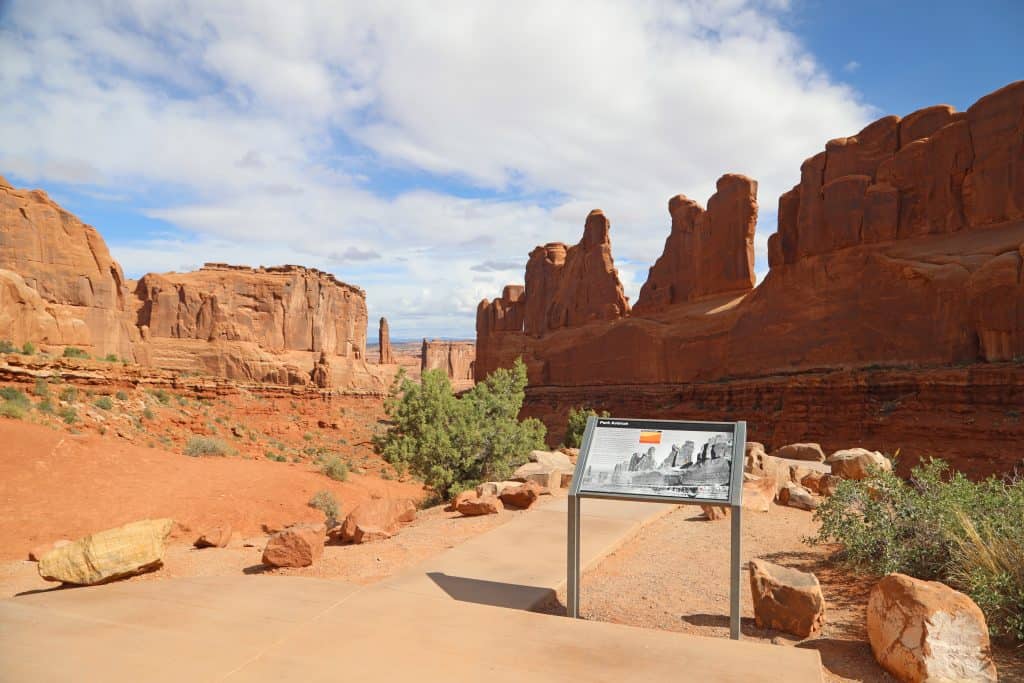
List of National Parks in Utah
- Arches National Park
- Bryce Canyon National Park
- Canyonlands National Park
- Capitol Reef National Park
- Cedar Breaks National Monument
- Dinosaur National Monument
- Glen Canyon National Recreation Area (AZ, UT)
- Golden Spike National Historical Park
- Hovenweep National Monument (CO, UT)
- Natural Bridges National Monument
- Rainbow Bridge National Monument (by boat only)
- Timpanogos Cave National Monument
- Zion National Park
Affiliated Sites
- California National Historic Trail (CA, CO, ID, KS, MO, NE, NV, OR, UT, WY)
- Mormon Pioneer National Historic Trail (IL, IA, Ne, UT, WY)
- Old Spanish National Historic Trail (AZ, CA, CO, NV, NM, UT)
- Pony Express National Historic Trail (CA, CO, KS, MO, NE, NV, UT, WY)
There are 13 National Parks in Utah that receive over 13.9 million visitors a year! These visitors produce over $1 billion in economic benefits through tourism.
Utah National Parks include 2 National Heritage Areas, 1 Wild and Scenic River managed by the National Park Service, 4 National Trails, 1,830 National Register of Historic Place Listings and 14 National Historic Landmarks.
National Parks in Utah also includes 4 National Natural Landmarks, 674 places recorded by the Heritage Documentation Program, over 2.3 million objects in the Utah National Park museum collections and 6,831 archeological sites.
Learn more about National Park Passes for parks that have an entrance fee.
$80.00 - For the America the Beautiful/National Park Pass. The pass covers entrance fees to all US National Park Sites and over 2,000 Federal Recreation Fee Sites for an entire year and covers everyone in the car for per-vehicle sites and up to 4 adults for per-person sites.
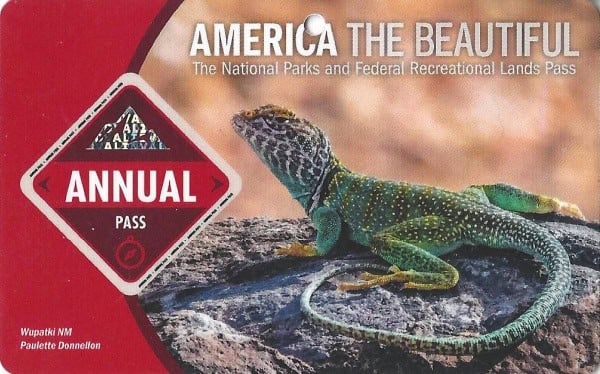
Buy your pass at this link, and REI will donate 10% of pass proceeds to the National Forest Foundation, National Park Foundation, and the U.S. Endowment for Forestry & Communities.
National Park Free Entrance Days -Mark your calendars with the five free entrance days the National Park Service offers annually.
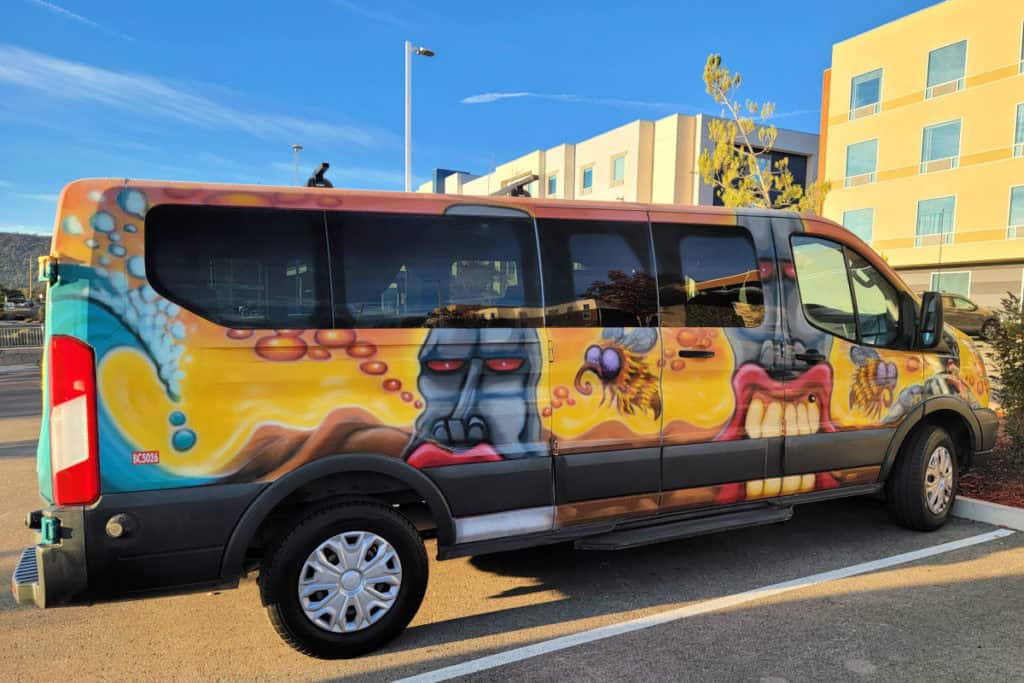
For a fun adventure check out Escape Campervans. These campervans have built in beds, kitchen area with refrigerators, and more. You can have them fully set up with kitchen supplies, bedding, and other fun extras. They are painted with epic designs you can't miss!
Escape Campervans has offices in Vancouver, Seattle, Portland, San Francisco, Las Vegas, Los Angeles, Phoenix, Salt Lake City, Denver, New York, and Orlando
Check out the National Parks in neighboring states
Do you know how many National Parks you have visited? Check out this printable list of National Parks to see how many of the 62 National Parks you have visited.
Have you ever wanted to work in our National Parks? Check out how to become a Park Ranger for information on what it takes to work in our amazing parks.
Make sure to follow Park Ranger John on Facebook, Instagram, Pinterest, and TikTok

